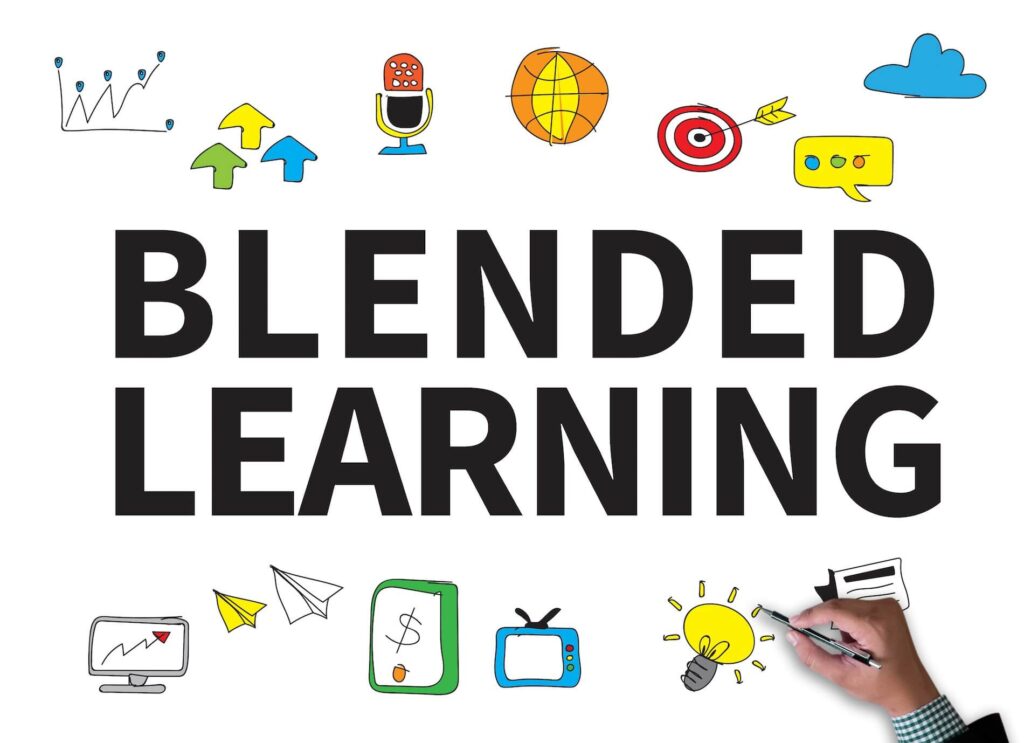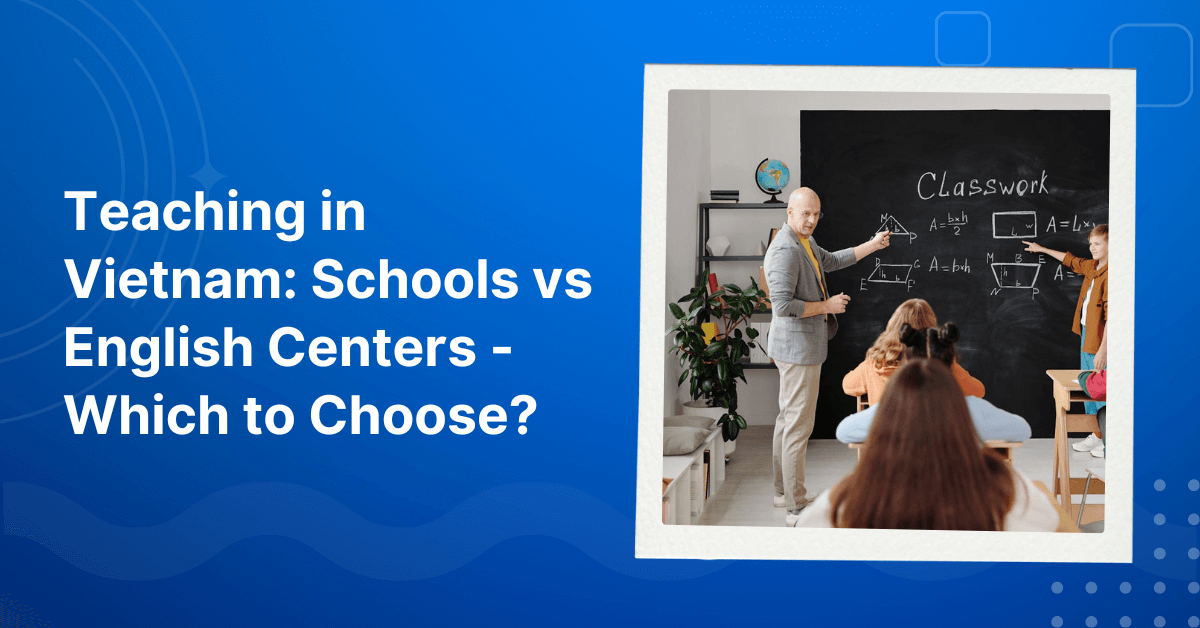Blended learning is a popular approach to education that combines traditional face-to-face instruction with digital learning tools and resources. In recent years, it has become increasingly popular in both K-12 and higher education, as well as in corporate training programs. This approach offers a variety of benefits, including increased flexibility, personalization, and engagement for learners. In this article, VTJ will explore the different types and examples of blended learning, as well as the benefits and challenges of implementing a blended learning program.
What is blended learning?

Blended learning is an educational approach that combines traditional face-to-face instruction with online learning activities. This model of learning integrates technology into the classroom, allowing students to complete coursework and engage in activities both in person and remotely. In a blended learning environment, students may participate in online discussions, complete interactive activities, and watch pre-recorded video lectures in addition to attending traditional classroom sessions. The goal of blended learning is to provide a more personalized and flexible approach to education, allowing students to work at their own pace and take greater control over their learning.
Blended learning can take many forms, depending on the specific needs and goals of the students and instructors. Some programs use a “flipped classroom” model, where students watch pre-recorded video lectures at home and then use class time for hands-on activities and collaborative projects. Others may incorporate virtual tutoring or coaching, allowing students to receive additional support outside of regular class hours. The flexibility of blended learning also makes it an ideal option for adult learners, who may need to balance their education with work or family responsibilities.
While blended learning can offer many benefits, such as increased engagement, flexibility, and personalization, it also requires careful planning and implementation. Effective blended learning programs must be designed with clear learning objectives and goals, and instructors must be prepared to support students both in person and online. Additionally, technology and internet access can be a barrier for some students, so it’s important to ensure that all students have access to the necessary tools and resources for success. Overall, blended learning can be a powerful approach to education when implemented effectively.
Discover Related Guides: TOP 10 Effective teaching Methods in Vietnam
What Is the Purpose of Blended Learning?
The purpose of blended learning is to combine the best of both traditional classroom instruction and online learning to create a more effective and engaging learning experience. Blended learning aims to provide students with flexibility in terms of when and where they learn, while also ensuring that they receive the benefits of face-to-face instruction and interactions with their peers.
Blended learning also seeks to personalize learning to meet the unique needs of each student. By incorporating online learning, teachers can create individualized learning paths and provide more targeted instruction and support. This approach allows students to progress at their own pace and receive extra help when needed, while also challenging advanced learners to move ahead at a faster pace.
Another purpose of blended learning is to increase student engagement and motivation. By integrating technology into the learning experience, teachers can use interactive multimedia resources and gamification elements to make learning more fun and engaging. This approach can help students develop a love for learning and encourage them to take ownership of their own education.
Overall, the purpose of blended learning is to create a more effective and efficient learning experience that prepares students for success in the 21st century. By combining the best of both traditional and online learning, blended learning can provide students with a personalized and engaging education that meets their unique needs and prepares them for the challenges of the future.
Continue Learning: 14 Types of Teaching Methods For an Effective Lesson
Who Benefits From Blended Learning?

Blended learning has the potential to benefit a wide range of learners, including students of all ages, teachers, and educational institutions.
One of the key beneficiaries of blended learning is students. Blended learning provides students with greater flexibility and control over their learning, allowing them to access materials and resources on their own schedule and at their own pace. This approach also provides opportunities for students to engage with content in multiple ways, such as through interactive online activities, videos, and simulations, as well as in-person discussions and activities. Blended learning can also help to personalize the learning experience for each student, allowing them to focus on areas where they need more support and challenging them to reach their full potential.
Teachers can also benefit from blended learning. This approach can help to reduce their workload by automating certain tasks and allowing them to focus on more personalized interactions with their students. Blended learning also allows teachers to access a wealth of resources and materials that can help to enrich their teaching and support student learning. Additionally, blended learning can provide opportunities for professional development and collaboration with other educators.
Educational institutions can also benefit from blended learning. Blended learning can help to increase access to education by removing barriers to entry such as geography, time constraints, and cost. This approach can also help institutions to reach a wider range of learners and provide more personalized learning experiences. Blended learning can also help to reduce costs associated with traditional classroom-based instruction, such as facilities and infrastructure, and allow institutions to be more flexible in their course offerings.
See More Strategies: Why Do You Want to be a Teacher? 15+ Best Interview Answers
What are the 6 types of Blended Learning Models?
1. Face-to-face driver model
The face-to-face driver learning model is a type of blended learning that provides learners with an experience similar to that of a traditional classroom setting. In this model, learners attend live webinars or meetings where they receive instruction and are given assignments or homework to complete before the next session.
One of the main advantages of the face-to-face driver learning model is its effectiveness for learners who require more external motivation or are in the early stages of their careers. Additionally, the model can be beneficial for learners who are less comfortable with technology and prefer a more familiar classroom setting. However, the face-to-face driver learning model also requires more time and effort from the instructor compared to other blended learning models.
2. Flipped model
The flipped learning model is an approach in which learners receive learning materials and resources prior to each virtual classroom session, which is similar to the face-to-face driver model mentioned earlier. The idea is that learners will come to the virtual classroom more prepared and with a better understanding of the material, allowing for more meaningful interactions with the instructor and other learners.
One of the key benefits of the flipped model is that it can increase learner engagement and participation, as learners have already had a chance to engage with the material on their own before the live session. Additionally, it can be a more efficient use of classroom time, as the instructor can focus more on facilitating discussions and activities rather than lecturing. However, this model also requires more preparation and effort on the part of the instructor to create and distribute the necessary learning materials.
3. Enriched virtual model
The enriched virtual learning model allows learners to set their own learning pace and complete most of their coursework virtually. Learners have the opportunity to attend webinars with the instructor at their convenience, but ultimately they determine how much of their learning involves live interaction with the instructor.
The enriched virtual learning model can be great for self-motivated learners who appreciate autonomous learning. By having the option to interact with the instructor, they enjoy the balance between feeling supported and not feeling hindered by mandatory live instruction at a set date and time. However, learners who prefer more structure and regular interaction with their instructor may find this model challenging. Additionally, instructors must be skilled in providing adequate support and feedback to learners who are primarily working independently.
4. Flex model
The flex learning model offers learners the opportunity to direct their learning according to what works best for them. They are able to jump between synchronous and asynchronous instruction, individual assignments, and even group learning. Instructors are available to answer questions and provide feedback, but it’s up to each participant how and when they utilize instructor resources.
The flex learning model is great for self-motivated learners who understand (or are willing to experiment with) how different instructional methods impact their learning. One downside to this, however, is that instructors must be “on call” (although much of this time is likely not spent engaging in active instruction). One other potential downside is that unmotivated learners may simply stick with the method of instruction that is most familiar to them, or seems the easiest or fastest, rather than embracing the personalization this learning model offers.
5. Rotation model
A rotation model is a form of blended learning where learners rotate between different learning experiences. These experiences typically include individual instruction via pre-recorded webinars, live group instruction via video conferencing tools, and self-guided assignments. Instructors typically determine the rotation schedule and tailor it to the specific needs of each learning cohort.
One of the biggest benefits of the rotation model is that it caters to a wide range of learning preferences. Learners get a mix of self-guided and instructor-led instruction, which helps them to maximize their preferred method of learning. However, the rotation model can be demanding in terms of organization, which is why many instructors rely heavily on a learning management system to make the learning experience as accessible and understandable as possible.
6. Online driver model
The online driver learning model is a type of blended learning that offers learners the maximum amount of autonomy. In this model, learners can progress through the learning materials at their own pace and according to their own motivation levels. While participants are still able to communicate with instructors as needed, such communication is not a requirement for completing the training.
One of the main benefits of the online driver learning model is that it requires the least amount of instructor time and energy, making it a cost-effective option for organizations that have a large number of learners. Additionally, self-motivated and experienced learners can thrive in this model, as they are able to take ownership of their learning and work at a pace that suits them best.
However, the online driver learning model may not be suitable for all learners, especially those who require more structure and guidance to achieve their learning goals. Learners who are not self-motivated or are unfamiliar with online learning environments may struggle to keep up with the course materials, potentially leading to frustration or a lack of engagement. Instructors may also need to design the course materials carefully to ensure that learners are able to access all the necessary resources and complete the course successfully.
Read Another Article: Teacher Strengths and Weaknesses: How to Answer?
How to create a blended learning program

Creating a successful blended learning program requires careful planning and consideration by the teacher. The first step is to identify the learning objectives and outcomes for the course. Once the objectives are established, the teacher can determine which parts of the curriculum are best suited for in-person instruction and which can be delivered online.
The next step is to choose the appropriate technology tools and platforms that will be used in the course. Teachers should consider the needs and preferences of their students when selecting the tools, as well as the resources and support available from the school or institution. Some common tools used in blended learning include learning management systems (LMS), video conferencing software, and online collaboration tools.
Explore More Teaching Tips: How to encourage students to speak more English in class
Teachers should also develop a clear schedule and timeline for the course, including both in-person and online components. This will help students to stay on track and understand what is expected of them. It is important to communicate this schedule and any changes to students regularly.
Finally, teachers should regularly assess the effectiveness of the blended learning program and make adjustments as needed. This includes gathering feedback from students and using data to analyze student progress and engagement. By regularly evaluating the program and making improvements, teachers can ensure that their blended learning program is meeting the needs of their students and achieving the desired learning outcomes.
Are you facing difficulties in finding and securing teaching positions in Vietnam? Are visa procedures causing you trouble? Feeling overwhelmed and directionless upon your arrival in Vietnam for teaching assignments? Don’t worry, VTJ’s English Teaching Placement in Vietnam (EPIV) Program 2024 provides comprehensive support to solve ALL the matters.
👉👉👉 Click HERE to request free consultation






